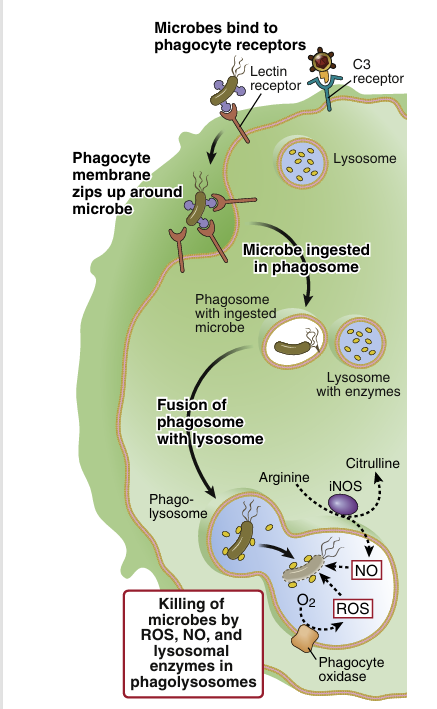


 النبات
النبات
 الحيوان
الحيوان
 الأحياء المجهرية
الأحياء المجهرية
 علم الأمراض
علم الأمراض
 التقانة الإحيائية
التقانة الإحيائية
 التقنية الحيوية المكروبية
التقنية الحيوية المكروبية
 التقنية الحياتية النانوية
التقنية الحياتية النانوية
 علم الأجنة
علم الأجنة
 الأحياء الجزيئي
الأحياء الجزيئي
 علم وظائف الأعضاء
علم وظائف الأعضاء
 الغدد
الغدد
 المضادات الحيوية
المضادات الحيوية|
Read More
Date: 2025-02-12
Date: 2025-04-20
Date: 6-11-2015
|
Neutrophils and macrophages ingest (phagocytose) microbes and destroy the ingested microbes in intracellular vesicles (Fig. 1). Phagocytosis is a process of ingestion of particles larger than 0.5 μm in diameter. It begins with membrane receptors binding to the microbe. The principal phagocytic receptors are some pattern recognition receptors, such as mannose receptors and other lectins, and receptors for antibodies and complement. Microbes opsonized with antibodies and complement fragments can bind avidly to specific receptors on phagocytes, resulting in greatly enhanced internalization . Binding of the microbe to the cell is followed by extension of the phagocyte plasma membrane around the particle. The membrane then closes up and pinches off, and the microbe is internalized in a membrane-bound vesicle, called a phagosome. The phagosomes fuse with lysosomes to form phagolysosomes.

fig1. Phagocytosis and intracellular killing of microbes. Macrophages and neutrophils express many surface receptors that may bind microbes for subsequent phagocytosis; select examples of such receptors are shown. Microbes are ingested into phagosomes, which fuse with lysosomes, and the microbes are killed by enzymes and several toxic substances produced in the phagolysosomes. The same substances may be released from the phagocytes and may kill extracellular microbes (not shown). iNOS, Inducible nitric oxide synthase; NO, nitric oxide; ROS, reactive oxygen species.
At the same time that the microbe is being bound by the phagocyte’s receptors and ingested, the phagocyte receives signals from various receptors that activate several enzymes. One of these enzymes, called phagocyte oxidase, rapidly assembles in the phagolysomal mem brane, mainly in neutrophils, and converts molecular oxygen into superoxide anion and free radicals, a process called the oxidative burst (or respiratory burst). These free radicals are called reactive oxygen species (ROS) and are toxic to the ingested microbes. A second enzyme, inducible nitric oxide synthase (iNOS), is produced mainly in macrophages and catalyzes the con version of arginine to nitric oxide (NO), also a microbicidal substance. A third set of enzymes, the lysosomal proteases, break down microbial proteins. All these microbicidal substances are produced mainly within lysosomes and phagolysosomes, where they act on the ingested microbes but do not damage the phagocytes.
additional mechanisms to destroy microbes. They can release microbicidal granule contents into the extra cellular environment. In response to pathogens and inflammatory mediators, neutrophils die, and during this process they extrude their nuclear contents to form networks of chromatin called neutrophil extracellular traps (NETs), which contain antimicrobial substances that are normally sequestered in neutrophil granules. These NETs trap bacteria and fungi and kill the organ isms. In some cases, the enzymes and ROS that are liberated into the extracellular space may injure host tissues. This is the reason why inflammation, normally a protective host response to infections, may cause tissue injury as well.
Inherited deficiency of the phagocyte oxidase enzyme is the cause of an immunodeficiency disorder called chronic granulomatous disease (CGD). In CGD, neutrophils are unable to eradicate intracellular microbes, and the host tries to contain the infection by calling in more macrophages, resulting in collections of activated macrophages around the microbes called granulomas.



|
|
|
|
حقن الذهب في العين.. تقنية جديدة للحفاظ على البصر ؟!
|
|
|
|
|
|
|
"عراب الذكاء الاصطناعي" يثير القلق برؤيته حول سيطرة التكنولوجيا على البشرية ؟
|
|
|
|
|
|
|
جمعية العميد تعقد اجتماعها الأسبوعي لمناقشة مشاريعها البحثية والعلمية المستقبلية
|
|
|